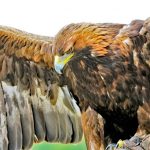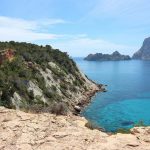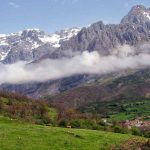Spain’s Living Landscape
For centuries a thriving, fought-over outpost, the central Spanish city of Segovia is now a popular tourism destination. “No city in Spain presents such a dramatic appearance…” reads the Fielding’s guide to Spain of Segovia, which gives it a top five-star rating. By all accounts, wild birds can’t read, but Segovia is also a prime stop for many enterprising fowl. Originally a Celtic town, Segovia fell to Roman conquest in 80 B.C. The Moors settled there about 700 years later, but were ousted by the Christians in 1085. These successive societies built houses of worship, forts, administrative buildings, and houses, and other structures. Their handiwork left much to inspire the historian or tourist, but birds also prize Segovia’s architecture for a different reason–it provides top-notch nest sites.
A naturalist visiting Segovia sees the town a bit differently than the typical visitor. First stop: the 163-arch aqueduct, a two-thousand-year-old remnant of Roman ingenuity built of massive, mortar-less granite blocks–where thousands of common swifts (Apus apus) and handful of thrushes called black redstarts (Phoenicurus ochruros) nest.
Next stop, the huge 23-chapel cathedral, which is one of the world’s largest and “newest” (16th century) Gothic cathedrals. This “Lady of all cathedrals” could also be considered one of the world’s largest and most costly birdhouses: Its extensive roofwork attracts cavity-nesting birds such as sickle-billed crows called choughs (Pyrrhocorax pyrrhocorax), rock (Petronia petronia) and house sparrows (Passer domesticus), spotless starlings (Sturnus unicolor), rock doves (Columba livia), and small, gray-headed crows called jackdaws (Corvus monedula). This palatable guest list draws a local peregrine falcon (Falco peregrinus) or two, while the peregrine’s smaller, more colorful cousin the lesser kestrel (Falco naumanni) nests on nearby rooftops.
And a few minute’s walk away, tight, winding streets yield to the Alcázar, a fairytale fortress embellished by centuries of rulers and the location where Isabella of Castille, of Ferdinand and Isabella fame, was named queen. Today, it is home to nesting and roosting white storks (Ciconia ciconia) and dozens of ash-colored swallows called crag martins (Ptyonoprogne rupestris).
Segovia’s wildlife appeal is not unusual for Spain, where history often meets natural history in seemingly timeless tranquility. Well-known for its rich history, unique customs, and delicious food, Spain is also beloved by naturalists as a hotspot for European wildlife. The Spanish countryside is littered with historic towns and ruins riddled with home possibilities for birds. Its small cities and towns shelter nesting birds that reverse-commute, feeding on the bounty of the surrounding, mostly cultivated countryside, where many other species remain full time to breed and feed.
Spain’s Natural Bounty
“Last bastion” is a term often used to describe Spain’s importance as a haven for Europe’s declining birds, and for good reason. Spain has the most intact and varied avifauna of any Western European country. About 70 percent of Europe’s 495 bird species annually breed in or visit the country. The EBCC Atlas of European Breeding Birds, an international effort to chart European birds species’ breeding abundance and distribution, reports that Spain holds the largest nesting populations of 99 species–about one-fifth of Europe’s bird species. In many cases, other European countries’ totals of these species don’t come a close second or third. For some species, Spain is the only European outpost, with the rest of their range lying across the Strait of Gibraltar in Africa. All told, about 70 percent of Europe’s bird species either visit or breed in Spain. The case is similar for the country’s 82 mammal and 53 reptile species.
History, climate, building trends, size, and population seem to all play a part in explaining why Spain remains full of rugged, rural landscapes that entice birds. “The Spanish people, rich and poor, congregate in town or village, and vast stretches of the ‘campo,’ as they call it, are thus left uninhabited, despoblados–relinquished to natural conditions…” wrote British hunters and adventurers Abel Chapman and Walter J. Buck in their 1893 book Wild Spain: Sport with Rifle, Rod, and Gun, Natural History, and Exploration. Today, although Chapman and Buck’s vision of a “…country so largely abandoned to nature…untouched by man, untamed and glorious in pristine savagery…” has changed, the visitor still gets their sense of “…the splendid abandonment of rural Spain.”
Spain’s economy lagged from the Spanish Civil War in the mid-1930s through much of the rule of dictator Francisco Franco, who died in 1975. During that time the strongly agrarian economy sustained itself on traditional agriculture, which slowly advanced over the decades. Modern machinery started finding its way to farms beginning in the 1950s. Today, the country’s economy is dynamic and booming. Farms are increasingly efficient and modernized, and irrigation is spreading.
In many cases, it is still true that the Spanish live in tightly packed towns and cities. Outside of large cities, Spain’s countryside remains largely agricultural. Centuries of farming swept away most of the country’s original low-elevation forest and grasslands. Today, the rural scenery reveals a continuous patchwork of farm crop fields, orchards, vineyards, and pastures stitched together by hedges, wooded streams, cliffs, and other wild ribbons of habitat. Much of the country is high plateau laced with even higher mountains, which hold rich forests that provide countless tucked-away wildlife enclaves. Despite widespread habitat alterations, there remains enough of wild Spain to keep naturalists busy for many lifetimes.
However, especially around high-priced and growing cities such as Madrid, suburbs now spill far out into the countryside as they do in the United States. There is also a burgeoning market for second homes, such as many communities being built in the mountains just outside Madrid. This trend will likely continue as the Spanish economy continues its current boom.
In many areas, marginal soils, a dry climate, and decades of economic hard times contributed to Spain’s abundance of open, rugged land. However, another factor plays strongly: Spain is not over-populated like other European countries, and it’s jumbo-sized by European standards. Slightly larger than France–a bit more than twice the size of Oregon–it supports a stable population of about 40 million people. By contrast, France, Italy, and the United Kingdom–which is about half the size of Spain–each have almost 60 million. Germany is also smaller, but is home to about 80 million people.
Look What the Stork Dragged In
In Segovia and many towns throughout central and southern Spain, no one can ignore perhaps the largest backyard birds in the world–white storks. With six-foot, black-and-white wingspreads and candy-red legs and dagger bills, few birds seem as impressive, and at times awkward, perched on a rooftop. Over the centuries white storks adopted human towns as nesting habitats, as long as prime feeding areas–pastures, wetlands, fallow fields–sat nearby. Although people valued them as good luck symbols in Spain and legendary baby-deliverers in Germany and other countries to the north, the birds seem too busy raising their own young to concern themselves with human affairs. They cram food into their chicks’ bills high above the fray, in bulky stick nests stacked and woven atop terra-cotta rooftops and towers.
Wetland drainage and modernized agriculture, as well as drought on their African wintering grounds, changed the storks’ prospects, causing sharp declines across Western Europe in the 20th century up through the 1980s. They vanished from some countries, such as Denmark, Sweden, Switzerland, and Italy, where some now only occur thanks to costly reintroduction programs. In Western Europe, Spain held, and holds, by far the largest population at more than 16,000 breeding pairs.
Spain’s stork population also suffered a sharp decline during the 1980s, and it remains on the country’s endangered species list under a “vulnerable” status. But even during the tough times, the country remained Western Europe’s stork stronghold for the same reasons why many other birds remain far more common there than elsewhere. First, marginal soils often require Spanish farmers to alternate their fields, leaving some to go wild, or fallow, to “rest” the soil. Open pastures are another common landscape in these areas. Pastures and fallow fields abound in insects such as grasshoppers and beetles, which are important stork foods, and other prey such as lizards, snakes, and, near rivers, fish and frogs. Also, the region’s dry, warm weather nurtures young storks. Cold, wet snaps cause high mortality, especially if they hit just after chicks have hatched.
These days, after a decades-long decline, white storks seem to be recovering in many parts of their range. Many scientists believe that recent wet winters on the birds’ African wintering grounds are responsible. Spain, however, plays an important role. Placed along white stork’s western migratory path (Turkey provides the key continental link east of the Mediterranean) Spain is important to storks that nest further north and pass by there on their way north or south to Africa. Increasingly, fewer storks make the entire journey. Instead, 3,000 or more white storks winter in Spain. In spring, central and southern Spain’s large breeding stork population provides wide-ranging recruits, which pop up and nest in Spain’s northern provinces, southwestern France, and perhaps farther north.
Part of the switch in wintering habits may stem from climate change, which scientists also speculate may explain other changes in Spanish bird behavior, such as why barn swallows (Hirundo rustica) now arrive there from African winter quarters about a month earlier than they did 30 or 40 years ago.
But trash also likely provides part of the enticement. Large dumps in the south and center of Spain provide a stinky smorgasbord not only for locally nesting storks but also those that migrate there from Germany, Holland, France, and other countries. Eating trash does not seem to harm most storks, although some, especially young birds, eat objects like rubber tubes or sponges, which snag in their digestive tracts and can kill or sicken them. Just outside Madrid, at Spain’s center, storks can now be found at the dump year-round. “What we have seen is that they mainly feed their young natural foods from food around here, especially during the first period of their development,” says Jose Aguirre, a biologist who studies white stork nestling survival. “What they keep for themselves is food from rubbish dumps.” Around Madrid, just-hatched nestlings seem to eat mainly insects, with a few frogs, snakes, or lizards. Aguirre and his colleagues discovered this by examining the pellets that young and adult birds regurgitate daily.
Seeking clear transmissions, radio, television and telephone companies have been busy erecting towers across Europe. Storks, seeking clear sight lines and good nest supports, flock to these structures. Just outside Madrid, for example, several dozen pairs nest on the National Radio transmission towers, including one so high that the parent storks and nest are nearly invisible to the naked eye. “That is probably the highest stork nest in Europe,” notes Aguirre as we drive past the fenced-off tower field.
Also, electric power line towers march across the landscape like seemingly endless, giant clothes lines. The lines prove a deadly obstacle to many storks, as well as other birds such as bustards, cranes, golden eagles (Aquila chrysaetos), and Eurasian black vultures (Aegypius monachus). These large birds collide with cables when dropping down to earth for a landing. In many cases, younger birds appear to be more vulnerable. The wires often blend with the landscape when seen from above, so the birds fly right into them. Storks and other birds are also electrocuted when they touch the lines.
Electric companies began installing colored disks that reveal the wires to incoming birds. Where present, these apparently reduce bird mortality. Although a menace for some birds, the growing electric power tower network also provides important nesting sites for others. Across Spain’s countryside, and in many other European countries, white storks are increasingly nesting on these elevated, out-of-town towers, as do ravens (Corvus corax), magpies (Pica pica), and some other birds.
Wherever white storks nest in Spain, other opportunists follow. For example, one day while birding just outside of Madrid, a friend and I spotted a large, lumpy stork nest, perhaps six feet tall and made of sticks stuffed into the frame of a rusted old radio tower. One stork–probably the female, which spends more time at the nest–was incubating her eggs atop the nest, while a jackdaw, house sparrows, and four monk parakeets (Myiopsitta monachus), South American parrots introduced and expanding around Madrid, prospected for nest sites in the dangling mass below.
Bustards and Kestrels
The past 15 years have brought significant changes to some Spanish farmlands. Irrigation, helped in part by EU funds, is spreading, as are larger, more mechanized farms where hedgerows and other wild features are carved away in order to maximize yield. Extensive fields of sunflower, for example, do not provide the varied plant and insect life that many open-area birds need to survive and feed their young.
Europe’s heaviest flying birds, great bustards (Otis tarda), are another potential loser if Spain’s agriculture changes dramatically. These striking cinnamon, gray, and white turkey-sized creatures, which can weigh up to 33 pounds, benefited from widespread deforestation centuries ago, inhabiting grasslands and fallow field that sprung up after dry-area oak woods fell in central and southern Spain. Today, Spain’s great bustard population–at about 20,000 birds–is the healthiest in Europe. Their habitat consists no longer of grassland, but rather cereal and fallow fields, and a strong population even persists just outside of Madrid, although spreading development threatens it. This bird’s smaller cousin, the little bustard (Tetrax tetrax), abounds in Spain, with more than 200,000 pairs–also the most anywhere in Europe.
Spain’s marginal soils may help assure a healthy future for its great bustards, at least where cereals, such as alfalfa, continue to grow. The hens nest hidden among the cereal plants, raising their young before the harvest, while males, females, and young slowly walk and guzzle down insects and seeds in nearby fallow fields. Spain is recognized as the worlds’ great and little bustard stronghold. The EU has invested some efforts at providing incentives for farmers in certain bustard-rich areas to keep up their traditional methods. Meanwhile, in other areas, irrigation of fields replaces cereals, promoting annually farmed crops that provide little food or shelter for bustards.
This type of treeless landscape perpetuated by cereal fields is also critical for many predatory birds, including the sleek lesser kestrel. While the news for Spanish wildlife living in Spain’s inhabited rural landscapes is generally good, the story of this small falcon is a marked exception. In the early 1960s, more than 100,000 pairs nested in Spain. Today, between 5,000 and 8,000 pairs–by far the most remaining in Europe–live there. These sweet-potato-orange, buff, and gray falcons nest in small colonies in church steeples, castles, and other high buildings, fanning out at dawn to hunt insects in surrounding farm fields. Still a familiar sight near and in Seville, where they nest near and circle the famous mosque-turned-church called the Giralda–the lesser kestrel’s fortunes are further hurt when old buildings are fixed up. In recent years, many more churches are being restored, perhaps due to the country’s growing affluence. Lesser kestrels are disappearing especially fast in areas outside Madrid, where houses and roads replace their feeding areas.
Wine Stoppers for Wildlife
Extremadura, Spain’s southwest province, is the world’s second largest cork producer, after Portugal. There, native cork oaks grow amid rough pastures, their famed bark periodically stripped to stopper Europe’s wine bottles without killing the trees. But the province is known not only for its cork, but also its pork: pata negra (black foot) ham is a regional specialty famed for its flavor, enriched from the cork oak acorns that dark Extremaduran pigs snuffle up beneath the gnarled, small-leafed trees. In this extensive habitat, a good portion of Europe’s common crane (Grus grus) population winters, also eating the acorns. During spring and summer, when cranes are on Scandinavian nesting grounds, turtle doves (Streptopelia turtur), woodchat shrikes (Lanius senator), booted eagles (Hieraaetus pennatus), and black kites (Milvus migrans) nest there.
The growing trend for wine-makers to use plastic stoppers, however, concerns cork growers and environmentalists alike. If plastic stoppers, currently used in bottling a small but growing percentage of European wines, prevail in years to come, the cork market might dive, forcing cork oak acreage to decline as growers plant different crops.
Another famed product of Spain, the olive, covers far more area but provides less rich digs for wildlife. Spain, along with Italy, Greece, and Tunisia, is one of the world’s top olive producers. In large groves spanning the drier parts of the country, rural creatures live, including a good part of the continent’s largest population of little owls (Athene noctua), diurnal insect-eaters that often seek shelter and nest in olive trees and nearby stone structures. Large groves, however, are monocultures catering to only a relatively few species. Small groves near other habitats, such as open fallow fields, sustain more biodiversity.
Perhaps no other bird concerns hungry Spaniards more than another rural denizen, the red-legged partridge (Alectoris rufa). During the fall hunting season, this plump gamebird, called perdiz in Spanish, is familiar fare in restaurants nationwide. Despite widespread hunting pressure and declines in other Mediterranean countries, red-legged partridges remain common in a wide variety of Spanish agricultural landscapes, from open fields to olive groves.
This bird’s future did not seem too bright to Abel and Buck, who, clearly perturbed, wrote in 1910: “The redleg–under the murderous system of shooting, year in and year out, over decoy-birds–would be exterminated within three or four years in any other country save this. It is merely the incredible fecundity of the bird and the vast area of waste lands that preserves the breed.” One modern problem is that farmed partridges are often introduced, making the wild population appear far more abundant than it is. Introductions also muddle the gene pool because farmed partridges sometimes have mixed lineage, being hybrids that are part non-native chukar (Alectoris chukar) or rock partridge (Alectoris graeca).
It might be premature to say that Spain will always remain a haven for birds failing in other European countries. While public and governmental concern for wildlife issues is growing in Spain, economic growth and enterprise are often more highly prized, bringing with them formidable environmental changes. Yet for long-term survival, species like the great bustard or lesser kestrel have no better stronghold than Spain. The future may yet be bright for these birds.
Standing on the Alcázar’s fortified walls, looking over a seemingly endless patchwork of farms, river bends, and woodlots, you can feel a calming timelessness. A Eurasian black vulture, Europe’s largest raptor, soars past and the clapping of stork bills fills the air. From this vantage point, and countless others across Spain, it is easy to believe there will always be a lot of wild in Spain’s not-so-wild landscapes.
Note: This article appeared in ZooGoer, a magazine of supporters of the National Zoological Park in Washington, D.C. Reproduced by kind permission of the author.







